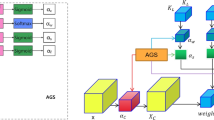Abstract
Recently, deep learning methods have been applied to ship classification in Synthetic Aperture Radar (SAR) images. However, because of the problem of imbalanced and insufficient samples in the SAR ship datasets, accurately identifying SAR ships still poses challenges. In this paper, we propose an improved T2T-ViT model based on the latent diffusion model, which expands the data set through image generation, and adds the SE attention mechanism to adjust the channel weight. To evaluate the effectiveness of the proposed method, training and experiments were conducted on the OpenSARShip 2.0 dataset. Our proposed model, in accordance with experimental results, achieves better recognition accuracy compared with existing models.
This work was supported in part by the National Natural Science Foundation of China under Grant 62271162 and 61971153, and Natural Science Foundation of Heilongjiang Province (YQ2022E016).
Access this chapter
Tax calculation will be finalised at checkout
Purchases are for personal use only
Similar content being viewed by others
References
Ren, H., Yu, X., Zou, L., Xhou, Y., Wang, X.: Joint supervised dictionary and classifier learning for multi-view SAR image classification. IEEE Access 7, 165127–165142 (2019)
Yang, T., Zhu, J., Liu, J.: SAR image target detection and recognition based on deep network. In: SAR in Big Data Era, pp. 1–4 (2019)
Guo, D., Chen, B., Zheng, M., Liu, H.: SAR automatic target recognition based on supervised deep variational autoencoding model. IEEE Trans. Aeros. Electron. Syst. 57(6), 4313–4328 (2019)
Hu, J., Shen, L., Sun, G.: Squeeze-and-excitation networks. In: IEEE/CVF Conference on Computer Vision and Pattern Recognition, pp. 7132–7141 (2018)
Ronneberger, O., Fischer, P., Brox, T.: U-net: convolutional networks for biomedical image segmentation. In: Navab, N., Hornegger, J., Wells, W.M., Frangi, A.F. (eds.) MICCAI 2015. LNCS, vol. 9351, pp. 234–241. Springer, Cham (2015). https://doi.org/10.1007/978-3-319-24574-4_28
Li, B., et al.: OpenSARShip 2.0: a large-volume dataset for deeper interpretation of ship targets in sentinel-1 imagery. In: Big Data Era: Models, Methods and Applications, pp. 1–5 (2017)
Vaswani, A., et al.: Attention is all you need. In: Neural Information Processing Systems, pp. 5998–6008 (2017)
Jaegle, A., et al.: Perceiver: general perception with iterative attention. In: Proceedings of the 38th International Conference on Machine Learning, vol. 139, pp. 4651–4664 (2021)
He, J., Wang, Y., Liu, H.: Ship classification in medium-resolution SAR images via densely connected triplet CNNs integrating fisher discrimination regularized metric learning. IEEE Trans. Geosci. Remote Sens. 59(4), 3022–3039 (1998)
Xu, Y., Lang, H.: Ship classification in SAR images with geometric transfer metric learning. IEEE Trans. Geosci. Remote Sens. 59(8), 6799–6813 (2021)
Xiong, G., Xi, Y., Chen, D., Yu, W.: Dual-polarization SAR ship target recognition based on mini hourglass region extraction and dual-channel efficient fusion network. IEEE Access 9, 29078–29089 (2021)
Wang, C., et al.: Semisupervised learning-based SAR ATR via self-consistent augmentation. IEEE Trans. Geosci. Remote Sens. 59(6), 4862–4873 (2021)
Lecun, Y., Bottou, L., Bengio, Y., Haffner, P.: Gradient-based learning applied to document recognition. Proc. IEEE 86(11), 2278–2324 (1998)
Veerapaneni, S.-K., Biros, G.: A high-order solver for the heat equation in 1D domains with moving boundaries. Siam J. Sci. Comput. 29, 2581–2606 (2007)
Han, K., et al.: Transformer in transformer. In: Neural Information Processing Systems, pp. 15908–15919 (2021)
Howard, A.-G., et al.: MobileNets: efficient convolutional neural networks for mobile vision applications. In: IEEE/CVF Conference on Computer Vision and Pattern Recognition, pp. 432–445 (2017)
Huang, G., Liu, Z., Laurens, V., Weinberger, K.: Densely connected convolutional networks. In: IEEE/CVF Conference on Computer Vision and Pattern Recognition, pp. 2261–2269 (2016)
Zhang, X., Zhou, X., Lin, M., Sun, J.,: ShuffleNet: an extremely efficient convolutional neural network for mobile devices. In: IEEE/CVF Conference on Computer Vision and Pattern Recognition, pp. 6848–6856 (2016)
Dosovitskiy, A., Beyer, L., Kolesnikov, A., Weissenborn, D., Houlsby, N.: An image is worth 16\(\times \)16 words: transformers for image recognition at scale. In: International Conference on Learning Representations, pp. 1–22 (2021)
Liu, Z., et al.: Swin transformer: hierarchical vision transformer using shifted windows. In: IEEE/CVF Conference on Computer Vision and Pattern Recognition, pp. 9992–10002 (2021)
Yuan, L., et al.: Tokens-to-Token ViT: training vision transformers from scratch on ImageNet. In: IEEE/CVF Conference on Computer Vision and Pattern Recognition, pp. 538–547 (2021)
Author information
Authors and Affiliations
Corresponding author
Editor information
Editors and Affiliations
Rights and permissions
Copyright information
© 2024 The Author(s), under exclusive license to Springer Nature Singapore Pte Ltd.
About this paper
Cite this paper
Qi, Y., Wang, L., Li, K., Liu, H., Zhao, C. (2024). Latent Diffusion Model-Based T2T-ViT for SAR Ship Classification. In: Sun, Y., Lu, T., Wang, T., Fan, H., Liu, D., Du, B. (eds) Computer Supported Cooperative Work and Social Computing. ChineseCSCW 2023. Communications in Computer and Information Science, vol 2013. Springer, Singapore. https://doi.org/10.1007/978-981-99-9640-7_22
Download citation
DOI: https://doi.org/10.1007/978-981-99-9640-7_22
Published:
Publisher Name: Springer, Singapore
Print ISBN: 978-981-99-9639-1
Online ISBN: 978-981-99-9640-7
eBook Packages: Computer ScienceComputer Science (R0)





